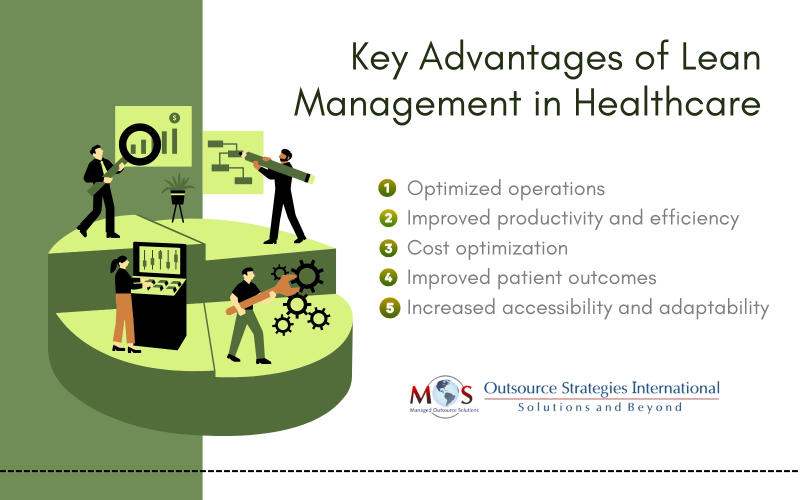The healthcare industry, frequently confronted with a multitude of challenges, inefficiencies, and limitations, is consistently seeking innovative solutions to optimize its processes. As the demand for more efficient workflows, improved patient outcomes, and enhanced revenue continues to grow, healthcare organizations are turning to progressive methodologies to stay ahead. Among these, the adoption of the Lean management system stands out. Originally a principle of automotive manufacturing, Lean has been thoughtfully adapted and embraced for healthcare process improvement, offering a transformative approach to minimize waste, streamline operations, and drive meaningful enhancements in care delivery. Healthcare organizations can outsource to a medical billing company with expertise in lean methodologies to achieve greater operational efficiency, ensure more accurate billing, and improve overall financial performance, allowing them to better allocate resources towards enhancing patient care and outcomes.
What are Lean Principles in Healthcare?
Lean management in medicine refers to the continuous and iterative system of maximizing value in a medical practice by identifying actions that add value to patient care. It is a framework built on the idea of sustaining the highest level of quality without adding expenses, staff, or resources. By adopting an ongoing optimization loop across the healthcare organization, lean principles streamline operations, eliminate waste, and enhance the overall quality of care delivery. According to the Virginia Mason Institute, the core facets of implementing lean methodology in healthcare are as follows:
- Develop and promote a culture of continuous improvement in healthcare.
- Implement value-based healthcare delivery – apply processes that provide value from the patient’s perspective and eliminate activities that don’t add value.
- Align leaders and staff members around a shared goal and desired outcomes.
- Empower front-line staff to drive improvement efforts while giving them the time and tools to find inefficiencies and devise effective methods.
- Find out the root cause of pain points and address flawed processes to prevent future mistakes.
Lean Methodologies in Healthcare
In the context of lean healthcare, robust methodologies have been incorporated into routine care delivery to achieve a system of constant improvement that eliminate wastes, reduce costs, and improve quality of care. Here’s how lean methodology improves hospital efficiency:
- Value Stream Mapping: This is a visual tool that allows healthcare organizations to map and analyze the flow of materials and information at each stage of care, helping to identify value-added activities and eliminate inefficiencies.
- Kaizen: Kaizen in healthcare focuses on continuous, incremental improvements on a daily basis by engaging all team members in identifying and solving problems to streamline processes.
- Kanban: This technique uses visual cards or signals to display task status, manage the flow of work, and ensure resources are available when needed, thereby improving efficiency.
- 5S: The 5S methodology consists of 5 principles: Sort, Set in Order, Shine, Standardize, and Sustain. 5S aims to promote cleanliness, order, and standardization to ensure a productive and safe work environment.
- Lean Six: Lean six sigma is a combination of two management strategies: Lean and Six Sigma. These optimize operations and improve patient care. It merges Lean’s focus on waste reduction with Six Sigma’s metric-driven system to reduce process variation, aiming for operational excellence.
Key Benefits of Lean Management
Lean management is not just about process optimization – it’s a proactive, transformative strategy that cultivates a culture of continuous learning, ensuring the highest level of care quality. By adopting lean principles, healthcare providers can unlock tangible outcomes, including reduced patient wait times, decreased administrative burden, the elimination of operational silos, and enhanced overall performance.
Here are the key benefits of lean healthcare in clinical settings:
- Optimized operations: A lean mindset aligns every staff member, from the chief medical officer to the front-desk receptionist, around a shared vision focused on adding value to patient service. This alignment ensures that time, effort, and processes are redirected towards patient-centered care, fostering a collaborative environment and driving optimized operations.
- Improved productivity and efficiency: By addressing process inefficiencies and implementing corrective actions, lean practices can create an environment where staff members feel engaged, valued, and empowered. This results in increased productivity, higher efficiency, reduced staff burnout, lower turnover rates, and improved employee engagement.
- Cost optimization: Lean’s central focus on eliminating waste, whether through unnecessary steps, processes, or activities, leads to better resource utilization and significant cost savings. By minimizing redundant diagnostic tests, medical procedures, and faulty equipment, healthcare facilities can maximize infrastructure use, enhance inventory management, and improve resource allocation, ultimately reducing clinical, operational, and administrative expenses.
- Improved patient outcomes: Lean management focuses on enhancing the activities and processes that directly impact the patient experience. This approach not only improves the quality of care but also increases patient satisfaction. Continuously eliminating non-value-added tasks such as long wait times, unnecessary transportation, duplicate tests, and medication orders for discharged patients enables healthcare providers to deliver more effective, patient-centered care.
- Increased accessibility and adaptability: Cost savings in healthcare organizations do more than improve profitability; they also enhance patient accessibility. Affordable services are crucial to the long-term success of any practice, and eliminating unnecessary medical costs ensures a smoother, more seamless patient journey. Moreover, lean’s iterative approach encourages flexibility, enabling organizations to quickly adapt to changing patient needs, regulatory updates, or emerging healthcare trends. This adaptability ensures that providers stay competitive in a fast-evolving industry.

How to Implement Lean Thinking in Healthcare
Lean principles provide an effective solution to common challenges such as inefficient workflows, inadequate resources, rising costs, and subpar performance in healthcare facilities. It provides a supportive framework for streamlining workflows, developing patient-centered care models, and boosting return on investment (ROI), ultimately fueling sustainable growth for practices. Let’s go through the key steps involved in successfully incorporating lean strategy:
- Assess current process
Start by evaluating the current state of the clinical processes and administrative workflow to identify inefficiencies, bottlenecks, and areas for improvement. Engage with staff from all levels at the organization to gather insights and understand challenges, especially those not immediately visible at higher levels. This helps to create a roadmap for the implementation process.
- Define Clear Objectives
Following the assessment, establish clear, measurable goals tailored to your practice’s needs. Focus on areas such as improving patient care, reducing waste, and lowering costs. Ensure that the lean implementation objectives align with the overall mission and vision of your organization.
- Map and Streamline Processes
Develop a detailed roadmap for lean strategy by involving key stakeholders, managers, and staff in the process to ensure collaborative and unified results. Visualize workflows to identify redundancies, delays, and non-value-added activities. Simplify and streamline these processes using lean principles to eliminate waste and improve flow, ensuring that every step adds value to the patient experience.
- Educate and Train Staff
Lean strategy is not a one-time process; it is an ongoing learning process that requires ample amount of knowledge and skills in lean principles to be most effective. Provide training to staff on core concepts and techniques such as 5S, Kaizen, and value stream mapping. This aids in a smoother transition to lean initiatives, reducing staff resistance and encouraging active participation across all levels of the practice.
- Monitor, Measure and Improve
Implement regular monitoring and performance tracking with Key Performance Indicators (KPIs) to measure the progress towards defined objectives. Using data analysis and feedback loop to discover inefficiencies, refine processes, and make data-driven decisions further optimize daily operations.
Healthcare organizations grappling with resource waste and financial constraints can streamline their processes and successfully implement lean strategy with outsourced medical billing services. By selecting an external partner specializing in lean principles, organizations can ensure that billing operations are optimized for efficiency and accuracy. Outsourcing to a partner with expertise in lean methodologies allows healthcare providers to eliminate billing errors, reduce administrative overhead, and optimize their revenue cycles.
Say goodbye to billing hassles and maximize your practice’s potential for increased profits with our medical billing services!




